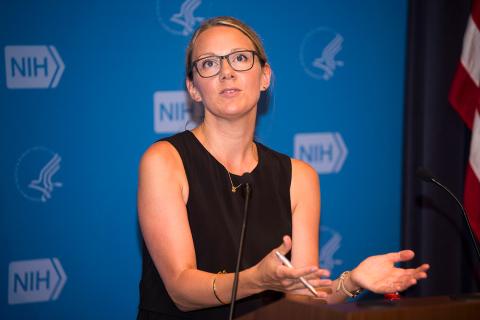Knowledge Equals…?
NHGRI Alum Studies Reactions to Genomic Information

Photo: Lisa Helfert
On the 15th anniversary of the founding of NHGRI’s Social and Behavioral Research Branch (and the 25th anniversary of the institute itself), one of SBRB’s first postdoctoral fellows—Dr. Saskia Sanderson, who arrived in 2007—returned to a kind of hero’s welcome recently when she explored the psychological impact of learning one’s personal genetic information during a talk in Lipsett Amphitheater.
It wasn’t like World Cup cheering in a soccer stadium, but it was a bit more boisterous than the usual welcome accorded speakers giving rounds. It was a homecoming after all, acknowledging the success of an alumnus—Sanderson has since gone on to research positions in Manhattan and, currently, in London.
A senior research associate at University College London, Sanderson discussed the utility of genome sequencing for physical and mental health—the balance of benefits versus risks that people compute internally when they stand to know more about their likelihood of disease than they would have had the human genome never been sequenced.
She described a patient, Paul, an otherwise healthy British double-bassist who smoked 20 cigarettes a day and suffered a heart attack at age 37. Would he have changed his behavior had he known his genetic risk of cardiovascular disease, Sanderson wondered?
Paul turned out to be Sanderson’s father, still alive, fortunately, and happy to be able to cavort with Sanderson’s young son.
With “tens of millions of people” expected to have their genomes sequenced in coming decades—there are already an estimated 25 million people worldwide participating in genome cohort studies—it is important to study the impact this new knowledge will have on individuals’ health and behavior, Sanderson believes.
She reviewed a number of studies undertaken in the past decade suggesting that when single genes are examined—such as GSTM1 as a marker for increased risk of lung and esophageal cancer—and a person’s risk is found to be relatively low, there is little impact on behavior.
“That’s a finding that has really permeated our field,” Sanderson said, “that testing doesn’t impact behavior.” It may, however, prompt initiation of medication and future screening.

Photo: Lisa Helfert
After her NHGRI postdoc, Sanderson moved to Icahn School of Medicine at Mt. Sinai in New York City. She and her colleagues studied biobank enrollees’ attitudes toward taking part in genomic studies and eventually developed an online education tool to explain whole-genome sequencing to the public.
“We wanted to help people make decisions if they were invited to participate in genomic research.”
Another project called HealthSeq examined the utility of participating in genomic studies for people who were in good health. Thirty-five people had their genomes sequenced.
“At the end of the study, most people wanted a hard drive with their raw data, but no one knew what to do with it,” Sanderson reported.
Her studies have revealed some interesting dimensions of research participation:
- Scientists want to include diverse populations for robust results, but people in Harlem, just north of Mt. Sinai, proved too under-insured to enroll; they could not afford the care they might need if something negative turned up.
- Simple curiosity and concern about risk of disease motivate most people to participate in genetic studies.
- As polygenic, rather than single-gene, risk scores become available, based on millions of common DNA variants, it will become even more important to evaluate the benefits vs. harms of such testing.
“We hope to be able to identify early those at risk of developing mental health problems,” Sanderson noted, “but the harm is the stigma involved…How do we maximize the benefits and minimize the harms?...We need to do this right, if we’re going to do it.”
During a brief Q&A session, Sanderson concluded, “None of this information is deterministic—it’s all about risk…People have a hard time with risk. They want hard answers, yes or no. Communication is a big issue. We have to work out how to talk to people about this. It’s an uncertain field.”
The talk was part of the NHGRI intramural program’s silver anniversary summer seminars, given by successful NHGRI trainees.
